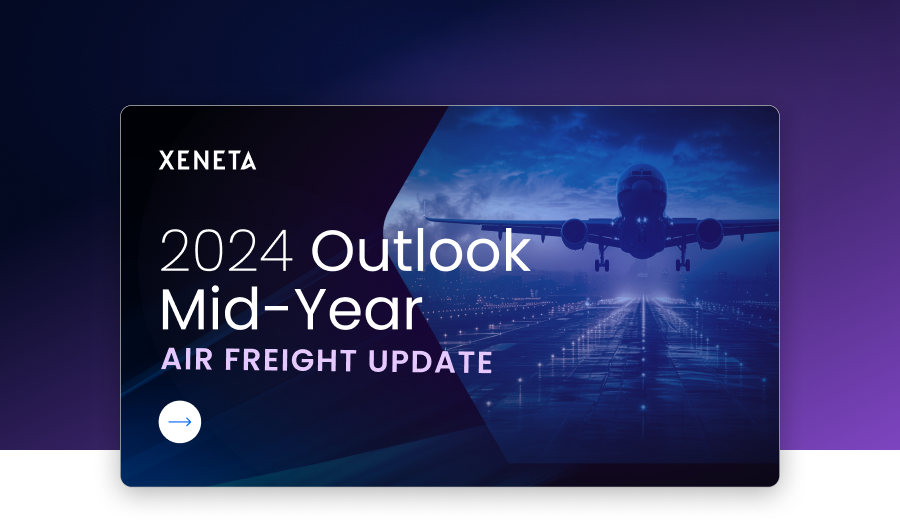Falling spot market rates.
Rising long-term rates.
Narrowing of market spread.
Carriers toughening negotiations on long-term rates.
Potential strikes in ports from 1 Oct on the US East and Gulf coast.
These were just some of the observations to come out of July’s State of the market webinar.
As well as expanding on key insights from the 2024 Mid-Year Ocean Market Outlook, hosts Michael Braun and Peter Sand answered the big question, where is the market heading, and what's on the horizon for shippers for the remaining months of 2024.
Here are some of the key takeaways from the webinar.
“No two crises are the same”
As Sand noted in the opening segment of the webinar, the Red Sea crisis has been particularly topical during the first seven months of 2024. Not only did it elevate ocean rates at an unprecedented pace, it has continued to have far-reaching ripple effects spanning ocean, air and everything in between.
More than this, the Red Sea crisis has undeniable similarities to market conditions during COVID.
As Sand explained, “the fundamental cause of the [Red Sea] crisis and the explosion of freight rates, in particular the spot rates and exclusively out of Far East, has led to higher freight spent for shippers, less predictability, poorer service levels and everyone struggling to get their goods across from where they are manufactured to where they are consumed.”
Braun also noted the similarities, pointing to Asia and West Coast Ports to highlight similar patterns of market behaviour with regards to congestion and carriers driving rates up on long-haul, outbound lanes.
The striking difference between these two crises, however, is that “the origin of the COVID was demand-driven, whereas the origin of the Red Sea is supply-driven.”
And this suggests that shippers can play a part in helping to ease the pain points in global supply chains.
Capacity is causing a conundrum
The smarter way for carriers to deploy capacity right now is, of course, where rates are highest. This is resulting in congestion on main hauls from Asia into Europe, as well as Singapore – the world’s largest transshipment hub, which became an epicenter of port congestion in the Far East for much of Q2 2024.
Front-loading efforts by shippers are also contributing to this Q3 squeeze.
As Sand remarked: “there are tendencies from the demand side also, where far eastern exports are booming and some of the main destinations, in particular in Europe, but also US, seem to be driven more by either inventory building or shippers trying to avoid a massive squeeze in the third quarter by front loading cargo.
"We are seeing nominal TEU-demand go up by 2½-4% y-o-y. And while these figures wouldn’t raise the alarm in a ‘normal’ year, once you’ve adjusted for the longer sailing distances, a few percent changes in TEUs can become quite significant double digits in TEU-miles, and it's that multiplier [longer sailing distances] on the world's most important trades that’s causing havoc on the market.
“The reason why such a high spot market is causing a little bit of a conundrum going into the second half of the year is because where demand was anticipated to ease, we're still expecting supply to deliver as much as 800,000 TEUs, reaching a total supply growth for the entirety of the year around 9%."

Long-term rates on major fronthauls show signs of life, just as spot rates start to soften
Reviewing current market conditions, Sand and Braun anticipate a continuing trend of easing rates on the short-term market, particularly on the Transpacific lanes. They also reported a narrowing of market spread between short and long-term.
Long-term rates on major fronthaul trades were shown to have increased in recent weeks, despite having remained subdued in the midst of massive increases on the short-term market in May and June. More notably, the underlying XSI® sub-index for Far East Exports – which includes the world’s biggest fronthaul trades to Europe and the US – increased 12.6% in July to 178.8 points.
As Braun explained:
"During COVID the long-term uptake was significantly longer and more stable and then it was falling off a cliff. This time we clearly see a different behavior and we can expect that it's not going to be repeated, especially with the uncertainty on the US East Coast.”
You can read more on short-term and long-term market trends in the most recent XSI® data highlights.
Alternatively, if you want a glimpse as to where the market is heading, watch the webinar on-demand to catch Xeneta’s market forecast.
As Sand notes:
“What will make the second half of 2024 interesting to watch is two factors. One, how do carriers react, and how do they deploy the new build capacity coming in on top of the 1.8 million TEUS that have already been delivered into a red-hot market? Two, will shippers keep their cool in the midst of market unpredictability?”
Trade as a political tool
Throughout the session, Braun and Sand brought attention to the political aspects affecting trade, such as the ‘bidding war’ on tariffs on imports from China, potential strikes on the U.S. East Coast and presidential elections. These factors have a high risk of impacting procurement efforts in the supply chains and necessitate contingency planning for shippers and carriers alike.
The hosts also spoke to the significant changes in alliances, especially the anticipated reorganization involving the Gemini alliance and MSC. It was highlighted that the implementation of a focused network to enhance service efficiency is crucial for managing potential congestion.
Environmental Concerns and Emissions
Despite a general intent to reduce emissions, market realities push against these goals, indicating a complex interplay between operational efficiency and environmental commitments.
Fortunately, the latest data, released by Xeneta and Marine Benchmark, revealed that the CEI is now back under 100 points, a mark which was breached for the first time in Q1 this year. That said, the three long haul trades most impacted by the conflict in the Red Sea – from the Far East to North Europe, Mediterranean and US East Coast – have seen emissions increase from Q1.

It is also important to note that, while emissions per tonne of cargo have fallen across Xeneta’s top 13 trades, this hides an increase in total emissions across the global container shipping fleet.
Next steps:
Xeneta advocates for a multi-faceted approach to understanding market dynamics.
As a first step, we highly recommend downloading the 2024 Mid-Year Ocean Market Outlook for deeper insights into the topics referenced during the webinar.
We also invite you to consider joining us in Amsterdam, Netherlands this October for the highly anticipated Xeneta Summit.
And of course, you’re welcome to revisit the webinar on-demand, so you can catch the insights that didn’t quite make this blog.







